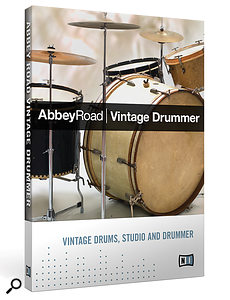Once again, the Native Instruments team has been at Abbey Road studios, recording a couple of vintage drum kits to create a library with a unique and desirable sound character. Although the Abbey Road 60s Drummer library is still the real headline grabber of the collection (the others are Abbey Road 70s, 80s, 90s and Modern Drummer), Vintage Drummer is free to be itself, and doesn't have to satisfy customers who want to create a virtual Ringo.
 By most standards, the library is large, apparently comprising over 46,000 samples and weighing in at 7.4GB. This means that the kits don't load up in an instant (and downloading from the web takes an age), but it's still much faster than recording the real thing!
By most standards, the library is large, apparently comprising over 46,000 samples and weighing in at 7.4GB. This means that the kits don't load up in an instant (and downloading from the web takes an age), but it's still much faster than recording the real thing!
As with the previous libraries in the series, there are two instruments to choose from, both of which are represented by an interactive picture in the custom-designed Kontakt interface. The kits are labelled Ebony and Ivory and each can be loaded fully, or as less memory-hungry 'lite' versions. NI describe Ebony as being open, mellow and smooth sounding, and few would argue with that. For those who know their drums, it comprises original James Blades 12- and 13-inch toms and a 26-inch Leedy bass drum, all fitted with original calfskin heads.
The Ivory kit — a Slingerland Radio King kit — dates from the 1940s and is intended to be the tighter of the two. Its toms are larger, measuring 13 and 16 inches, yet the bass drum, at 24 inches, is marginally smaller than that of the Ivory. Once again, calfskin heads were in use throughout.
Both kits are, by today's standards, very warm sounding, but it is true to say that Ivory feels tighter: its sounds generally seem to have sharper attacks and more mid-frequency presence. It's possible that the mic and recording setup had as much a part in creating the sound character as the kit itself, but it doesn't really matter. The point is that the producers have provided an up-front vintage sound and a slightly looser one that sits back a little.
In my experience of scouring sample-library kits for something to fit a composition, it is often the snare that causes most problems, so I was more than pleased to find that Vintage Drummer offers three options per kit. When a mouse pointer loiters over the image of the snare, a little 'A, B and C' panel pops up, allowing the three options to be auditioned. Changing snare also changes the snare hit variations, which range from a clean strike in the middle of the skin, to ones that are coloured by a touch of rim. And, of course, every snare variation has its own round-robin sample variations and is made up of multiple velocity layers. Snares from the 1920s include a Black Beauty 14- by 5-inch Gut Snare and a 14- by 4-inch standard Black Beauty, a 14- by 5-inch George Laurence Stone, and a 13- by 3-inch Ludwig Tango. From the 1940s, there's a 14- by 6.5-inch Leedy Broadway and 14- by 5.5-inch Slingerland Radio King.
Mouse-clicking a drum or cymbal on the virtual kit also assigns its parameters to a control panel at the foot of the page, where characteristics such as OH Mix (overhead), Room Mix, Tune, Attack, Hold and Decay can be adjusted. Of course, multitracking a drum kit was not an option in the 1940s, but Vintage Drummer is very much a modern product, providing a fairly comprehensive mixer through which every close and kit mic feed can be altered and processed. Within the mixer is an editable effects chain comprising a bus compressor, EQ, tape saturation effect and transient shaper (plus there is a convolution reverb patched across a send/return bus). However, for a lot of projects, just loading up the kits and playing them will do the job perfectly well.
In terms of percussion, both kits have two crash cymbals, a hi-hat and a ride. The cymbals used include a Zildjian First Stamp from the 1930s and the thicker and larger Trans Stamp from a decade later, but which kit has which is not specified. Overall, the cymbals seem less bright than modern equivalents and are suitably authentic sounding. On top of that, there are sticks, claps, tambourine, cowbell, sandpaper, woodblock and spoons samples, all mapped to the lower keys.
This review wouldn't be complete without mentioning the modest library of MIDI groove patterns, which are essential building blocks for those of us too lazy or unskilled to program our own. The patterns are great starting points for compositions, but there aren't really enough fills, breaks, intros and variations for them to be used exclusively.
I'd certainly recommend Vintage Drummer to anyone wanting to simulate the sound and feel of pre-'60s music, particularly if it is jazz, swing or cinematic. For me, the kits evoked the sound of Fred Quimby era Tom & Jerry cartoons, in which composer Scott Bradley helped drive the action along by mixing jazz and orchestral themes with up-front drums and percussion.
Most importantly, though, the kits, helped by Studio 2's room ambience, sound really nice. Their quality is not diminished at all when played quietly, and they don't become unbearably harsh when turned up loud. Doubters should remember that although vintage records rarely feature drums prominently, the drum kits themselves sounded really good. Tom Flint
$127.13 (at current exchange rates)
